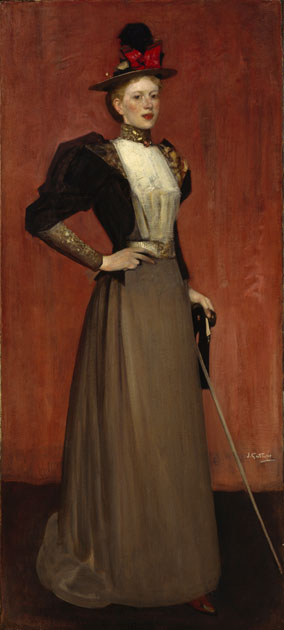Details
- Name
Maggie Hamilton
- Brief Biography
1867 - 1952, Scottish
- Occupation
Artist
- Description
-
Maggie Hamilton (1867–1952) was an embroiderer and painter of flowers and still-lifes. The daughter of Mary Stevenson and James Hamilton (d.1886), a prosperous Glasgow bobbin manufacturer, she was born in Kelvinside, Glasgow, but grew up in Helensburgh; the family were living at Bonnybrae, 80 Sinclair Street, Helensburgh in 1871 and by 1881 were at 87 Sinclair Street. By April 1886, when her father died, they had moved to Thornton Lodge, 107 Sinclair Street. She had a sister Mary Jane (d.1917) and an older brother, James Whitelaw Hamilton (1860–1932), who became one of the Glasgow Boys painters. On 20 April 1897 she married Glasgow architect Alexander Nisbet Paterson (1862–1947), younger brother of Glasgow Boy James Paterson (1854–1932), in Claremont Church, near Kelvingrove Park. They had two children (Mary) Viola Paterson (1899–1981), who became a painter, printmaker and designer, and Alistair (b.1900). Initially they lived at The Turret on Millig Street, Helensburgh (designed by A. N. Paterson), but in 1901 Paterson designed The Long Croft, West Rossdhu Drive, Helensburgh as a family home. An escutcheon above the front entrance contains their initials, symbols of architecture, painting and embroidery, and carved heads of their children. Guthrie & Wells stained glass windows in the drawing room also express their shared creativity: Embroidery, Architecture, Painting and Music. Hamilton contributed painted and embroidered panels to the interior. Hamilton attended a local private drawing academy, ‘The Studio’, at 8 then 3 Prince Albert Terrace, Helensburgh, run by Mary Park and Madge Ross; Norah Neilson Gray (1882–1931) also attended and Glasgow Boys Alexander Roche (1863–1921) and John Lavery (1856–1941) were visiting artists. Hamilton became friends with E. A. Walton’s sister Hannah (1863–1940) who taught china painting in Helensburgh. James Guthrie (1859–1930) painted them together in the garden of Thornton Lodge Midsummer (1892; Royal Scottish Academy). Viola wrote that her mother ‘spent a lot of time when young with “The Glasgow Boys”’. In the summers of 1884–85, she painted with them at Cockburnspath, Berwickshire. Hamilton appears in many of Guthrie’s paintings and pastels in the early 1890s, including an 1892-93 portrait in Glasgow Museums’ collection (acc. no. 2907), which she gifted to Glasgow Museums in 1951. Hamilton’s will (Paterson Collection, Special Collections, University of Glasgow), shows that she intended one of her paintings and several embroideries to be gifted to Glasgow Museums. However, these never came into the collection. In 1982 Viola gifted a number of textile items relating to her mother to Glasgow Museums.
Hamilton exhibited 51 paintings at the Royal Scottish Academy from 1889 (age 22). Although denied membership as a woman, she exhibited almost every year from 1903 until 1943. She also exhibited 92 works at the (Royal) Glasgow Institute of the Fine Arts from 1890, exhibiting 2-3 works every year (the most she could as a woman non-member), until 1944 (age 77). She also exhibited at the Royal Academy in London, Walker Art Gallery in Liverpool and Glaspalast, Munich, alongside the Glasgow Boys. She also showed her embroideries at Fra Newbery’s Arts and Crafts exhibition in 1895, Scottish Society of Art Workers in February 1899, Glasgow International Exhibition in 1901, Scottish National Exhibition of History and Industry in 1911 and Glasgow School of Art’s 1916 Ancient and Modern Embroidery and Needlecraft exhibition, for which she was a co-opted committee member. An artist member of the pioneering Glasgow Society of Lady Artists (later Lady Artists’ Club), probably from the early 1890s, she was the society’s Vice-President in 1928 and 1937 and on its hanging committee in the 1920s.
